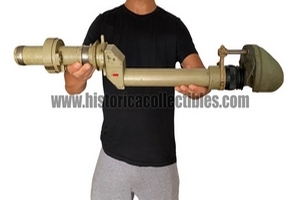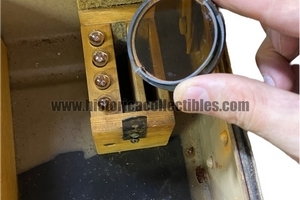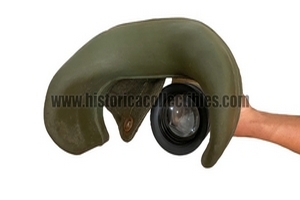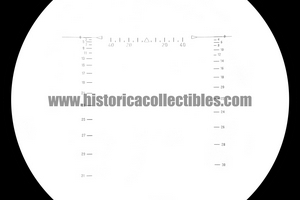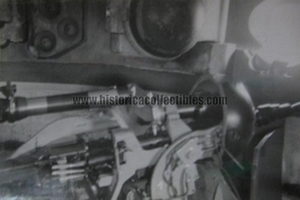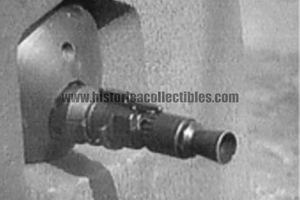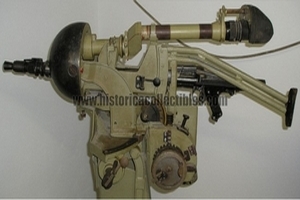P.Z.F.1 Zeiss Ikon, Panzer Zielfernrohr for MG34 Kugellafette with Metal Case, about 1941
P.Z.F.1 or Panzer Ziel Fernrohr Model 1, 2.5x with 28° vision, produced by Zeiss Ikon around 1941, complete with original transport metal case, specifically designed to be mounted on Sockellafette or MG34 Kugellafette installed inside the Bunker.
This deadly weapon, caliber 7.92x57 mm Mauser, had a rate of fire of 950/1000 strokes per minute at a speed of 755 m/s with a useful throw of 1200 meters, but thanks to this optic it was possible to reach, with impressive accuracy, a target at 3500 meters, in fact turning the steering wheel as you can adjust the elevation of the reticle and thus vary the flow of the shot.
Its total length is 80 cm and its weight is 7 kg.
Inside the original metal transport case, in addition to the housing useful for storing the front visor with a "blind eye", there are some accessories such as 1 orange filter useful for defining images in hazy conditions and some light bulbs replacement.
All the mechanisms work perfectly in a very smoothly and precise way.
Zeiss Ikon is a German company that was formed in 1926 by the merger of four camera makers (Contessa-Nettel, Ernemann, Goerz and Ica), and an infusion of capital by Zeiss The company formed one part of the Carl Zeiss Foundation, another part being the optical company Carl Zeiss. Logically, most of the Zeiss Ikon cameras were equipped with Carl Zeiss lenses and the formerly independent companies, in particular Goerz, had to shut down their own lens manufacture. The merged company was also obliged to use Compur shutters for 80% of its cameras. Thus only the simplest cameras could get cheaper shutters like the Klio. Soon AG Hahn für Optik und Mechanik, Kassel, and Goerz Photochemisches Werk GmbH, Berlin, joined the Zeiss Ikon syndicate. The group became one of the big companies in the phototechnical capital Dresden, with plants in Stuttgart and Berlin. Until WWII Zeiss Ikon was the world's market leading maker of 8mm movie cameras.
Carl Zeiss takes its name from its founder, Carl Zeiss, who on November 17, 1846 chose the small town of Jena, in Thuringia, as the location for his precision optical equipment factory. Thanks to the severe quality control that Carl Zeiss imposed on his products, going so far as to personally destroy the microscopes that did not pass the tests, the newly formed Zeiss became the official supplier of the University of Jena and received the gold medal of the industrial exhibition in 1861 of Thuringia as the best research instrument produced in Germany, awarded to the Stand I microscope of 1857.
In 1866 the thousandth microscope was produced and the name Zeiss became known throughout European scientific circles. Thanks to studies on the Porro prism, in 1893 Abbe patented double prism binoculars, which accentuated the perception of depth.
The mass production of Zeiss binoculars began in 1894, already at the beginning of the twentieth century more than 30,000 were made, at the beginning of the First World War the quota had risen to 500,000 and, at the end of the Second World War, as many as 2,260,000 were produced binoculars for the civil and military market.
Models were made starting from 4x11 mm to 12x40 mm, up to real giants such as the 80 mm and 100 mm. Thanks to studies conducted on the perception of light in low light situations, it was demonstrated that the average dilation of the pupil in an adult is approximately 7 mm.
For this reason, the 7x50 mm model was introduced in 1910 and remained on the market until 1917 with few changes to the materials used. In 1926, following the post-war crisis of the First World War with the Treaty of Versailles which bankrupted many important German companies, Zeiss purchased "C.P. GOERZ" and founded Zeiss Ikon in 1926.
In 1937 Zeiss had commercial contacts and factories in more than 29 countries around the world. From '33 Zeiss acquired interest from the Nazi regime, which balanced production towards military instruments. It successfully produced binoculars with wide-angle optics for military use, pressure-resistant optical systems for U-boats, periscope binoculars for targeting tanks. Furthermore, Zeiss cameras were mounted on the V2s for remote sensing operations of the English coasts.
On 1 November 1935, Zeiss, in the figure of Alexander Smakula, patented a process for the treatment of optical glass with extraordinary results in terms of light transmission. Remained a military secret until 1939, it was adopted on binoculars to reduce ghost images and internal reflections.
During the Second World War, there were numerous bombings against the Zeiss factories. Jena was bombed several times by the Allies starting in 1944.
Stuttgart was razed to the ground, although the Contessa-Nettel factory suffered little damage. The bombing of Dresden, in addition to devastating the city, also caused considerable damage to the Zeiss Ikon headquarters.
On April 13, 1945, American military forces entered Jena, surprising themselves that the bombing had not caused any significant damage. The main planetarium was in ruins, while the factories remained operational.


